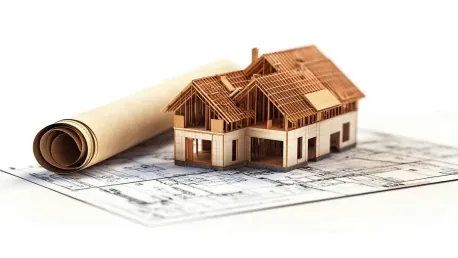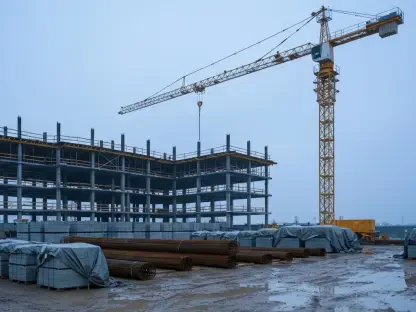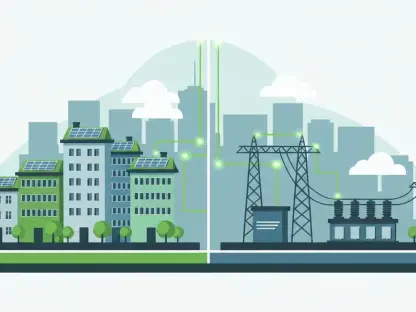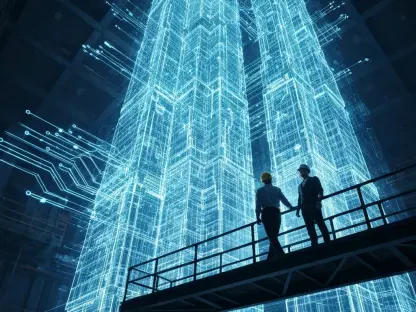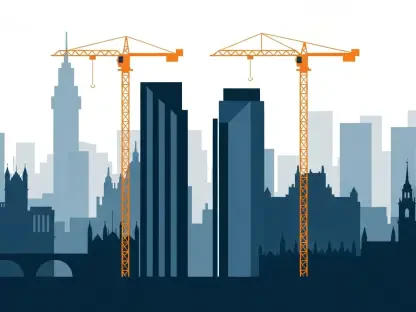The construction industry is on the brink of a significant transformation as we approach 2025. Driven by technological advancements and a growing emphasis on sustainability, the sector is evolving rapidly. This article delves into the top ten trends that are set to reshape the construction landscape, highlighting the key themes and insights that will define the future of construction.
AI & Automation
Artificial Intelligence (AI) and automation continue to revolutionize the construction industry by enhancing project management, optimizing workflows, and reducing costs. The AI in construction market is expected to grow significantly, driven by the need for improved efficiency and to address labor shortages. AI-powered solutions are being used to enhance various aspects, such as scheduling, resource allocation, risk management, and real-time safety monitoring through IoT sensors. Companies are increasingly turning to AI to handle complex and labor-intensive tasks that would otherwise require significant human intervention.
Startups like Nicky AI and Tri OM Adaptive Solutions are at the forefront of this trend. Nicky AI uses voice-enabled technology to streamline administrative tasks, allowing project managers to focus on more critical aspects of construction projects. On the other hand, Tri OM Adaptive Solutions integrates AI in planning and designing adaptable urban environments, ensuring urban spaces are both functional and efficient. These innovations are paving the way for a more efficient and automated construction process, reducing human error and operational costs.
Sustainable Construction
Sustainability is a major focus in the construction industry, with a strong emphasis on renewable materials, energy efficiency, and waste reduction. The market for sustainable construction materials is projected to grow substantially, reflecting a shift towards eco-friendly building practices. Technologies such as carbon-negative concrete, self-healing biomaterials, and nano-cellulose products are gaining traction as the industry moves towards more environmentally responsible choices. These materials not only reduce the carbon footprint of buildings but also improve their longevity and performance.
Innovative startups like WasteXpert and TRIQBRIQ are driving this trend. WasteXpert offers advanced waste management tools that enable companies to minimize and efficiently dispose of construction debris. Meanwhile, TRIQBRIQ provides modular timber construction systems that are both sustainable and easy to assemble. These solutions not only mitigate environmental impact but also promote efficiency in material usage. As a result, sustainable construction is emerging as a key trend for the future, reflecting a commitment to preserving natural resources and reducing the industry’s overall environmental footprint.
Modular Construction
Modular construction is gaining popularity due to its ability to enhance efficiency and reduce environmental impact. This method involves constructing building components off-site and then assembling them on-site, significantly cutting down project timelines and material waste. The modular construction market is expected to grow steadily, driven by labor shortages and the demand for rapid project execution. By building components in a controlled environment, modular construction ensures higher quality and consistency, minimizing waste and errors commonly encountered in traditional construction methods.
Startups like Fero International and CYME are utilizing modular techniques to offer sustainable and customizable building solutions. Fero International focuses on creating innovative modular units that cater to various purposes, including residential, commercial, and educational structures. CYME, on the other hand, leverages advanced modular construction techniques to provide tailored building solutions that meet the specific needs of their clients. By reducing construction time and material waste, modular construction is set to become a dominant trend in the industry, offering a viable solution to pressing challenges such as labor shortages and environmental concerns.
3D Printing
3D printing is set to revolutionize the construction industry by offering greater design flexibility, reduced labor costs, and minimized material waste. The market for 3D printing in construction is projected to grow at an impressive rate, facilitating the creation of complex architectural designs and supporting the construction of sustainable housing using eco-friendly materials. Innovations in 3D printing have made it possible to create intricate structures that would be difficult or impossible to achieve with traditional construction methods.
Startups such as 3D QUANTER and Aridditive are leading the way with advanced 3D construction printers and autonomous concrete 3D printing technology. 3D QUANTER’s solutions enable the construction of intricate designs, allowing architects and engineers to push the boundaries of creativity. Aridditive’s autonomous concrete 3D printing technology offers a high degree of precision and efficiency, streamlining the construction process and reducing labor costs. These innovations are enabling the construction of intricate designs and sustainable structures, making 3D printing a key trend to watch in the industry.
Building Information Modeling (BIM)
Building Information Modeling (BIM) technology is enhancing project planning and collaboration, significantly reducing construction delays and rework costs. The BIM market is forecasted to grow substantially, driven by government mandates and the integration of IoT and AI into BIM systems. By creating a digital representation of a building’s physical and functional characteristics, BIM enables stakeholders to visualize and collaborate on projects more effectively, reducing the likelihood of errors and misunderstandings.
Startups like RDS-BIM and Anker are offering cutting-edge BIM solutions that automate design processes and ensure data consistency. RDS-BIM’s platform streamlines the design and planning stages, improving project efficiency and reducing the risk of costly rework. Anker’s solutions focus on maintaining data consistency throughout the construction process, ensuring that all stakeholders have access to accurate and up-to-date information. By improving project efficiency and sustainability, BIM is becoming an essential tool in the construction industry, facilitating better decision-making and enhancing overall project outcomes.
Construction Management Software
Construction Management Software (CMS) is poised for significant growth, with cloud-based solutions becoming the industry standard. CMS facilitates real-time collaboration, streamlines operations, and enhances scalability for construction firms. This trend is particularly prominent in regions with large-scale infrastructure projects, where efficient project management is crucial. The adoption of cloud-based CMS allows construction teams to access project information from anywhere, improving communication and coordination among stakeholders.
Innovative platforms like Jack App and Gongsae-ro exemplify the integration of cloud-based tools and procurement solutions in improving construction management efficiency. Jack App offers a comprehensive project management platform that streamlines communication, scheduling, and resource allocation. Gongsae-ro focuses on optimizing procurement processes, ensuring that materials and equipment are available when needed, reducing delays and improving overall project timelines. As the demand for CMS grows, it will play a crucial role in the future of construction, enabling companies to manage projects more effectively and efficiently.
Construction Robots
Automation through construction robots is addressing labor shortages and enhancing productivity and safety on construction sites. The market for construction robots is expected to grow significantly, with robots performing repetitive and hazardous tasks, reducing human exposure to dangerous conditions, and improving project timelines. Construction robots can handle a wide range of tasks, from bricklaying and concrete pouring to demolition and site inspection, enabling human workers to focus on more complex and strategic aspects of construction projects.
Pioneering startups like Nextera Robotics and ARAV are providing autonomous site management robots and remote-controlled machinery. Nextera Robotics’ autonomous robots are designed to perform various construction tasks with precision and efficiency, reducing the need for manual labor. ARAV’s remote-controlled machinery allows operators to manage construction equipment from a safe distance, minimizing the risk of accidents and improving overall site safety. These innovations showcase the potential of robotics in modern construction, making it a key trend to watch in the industry.
Virtual Construction
Virtual construction technologies, including Virtual Design and Construction (VDC), digital twins, and extended reality (XR) tools, are transforming project planning and execution. These technologies facilitate real-time data sharing, predictive analytics, and immersive safety training, improving efficiency and reducing costs. By creating virtual representations of construction projects, stakeholders can identify and address potential issues before they arise, optimizing project outcomes and reducing the likelihood of costly errors.
Startups like qapture and Getafeel are developing digital twin solutions and 3D virtual tour platforms. Qapture’s digital twin technology creates accurate virtual models of physical assets, enabling real-time monitoring and analysis. Getafeel’s 3D virtual tour platforms allow stakeholders to explore construction sites remotely, improving communication and collaboration. These tools are enhancing project management and execution, making virtual construction a significant trend in the industry, and providing valuable insights that lead to better decision-making and more successful project outcomes.
Worksite Safety
The construction industry is prioritizing worksite safety by integrating advanced technologies such as wearable devices, AI-powered systems, and autonomous machinery. These innovations improve hazard awareness, predict potential risks, and enhance emergency responses. The worker safety market was valued at USD 3.1 billion in 2023 and is expected to grow significantly over the coming years. By leveraging technology to monitor and manage safety conditions, construction companies can create safer work environments and reduce the likelihood of accidents and injuries.
Startups like Need2Say and Safe At Site are developing tools to enhance communication, real-time monitoring, and safety equipment on construction sites. Need2Say’s platform enables workers to report hazards and incidents in real-time, ensuring prompt responses and mitigating risks. Safe At Site offers advanced safety equipment, such as wearable devices that monitor worker health and safety conditions, alerting supervisors to potential issues before they escalate. These innovations are set to transform worksite safety, making construction sites safer and more efficient.
Prefabrication
Prefabrication methods are becoming increasingly popular due to their efficiency and sustainability benefits. Prefabricated building systems minimize waste, reduce construction time, and leverage energy-efficient processes. This market is expected to grow from USD 12.22 billion in 2025 to USD 22.64 billion by 2035, reflecting the industry’s growing interest in off-site construction techniques. By assembling building components in a controlled environment, prefabrication ensures higher quality and consistency, reducing the likelihood of errors and rework.
Innovative startups such as Grhya and Rubera Prefabbricati focus on modular and prefabricated concrete structures, highlighting the trend’s versatility and scalability. Grhya offers customizable prefabricated solutions that cater to various building needs, from residential to commercial projects. Rubera Prefabbricati specializes in prefabricated concrete structures, providing durable and energy-efficient building components. By embracing prefabrication, the construction industry can achieve greater efficiency, sustainability, and cost-effectiveness, making it a key trend to watch in the coming years.
Conclusion
The construction industry is poised for a monumental shift as we edge closer to 2025. With technology advancing swiftly and a stronger focus on sustainability, the sector is undergoing rapid changes. This article explores the top ten trends that are set to revolutionize the construction landscape, offering insights and key themes that will shape the industry’s future.
Some of these transformative trends include the integration of smart technologies, like Internet of Things (IoT) devices and advanced data analytics, which improve efficiency and project management. Building Information Modeling (BIM) is becoming standard, revolutionizing the way projects are conceptualized and completed. The rise of modular and prefabricated construction methods is speeding up build times and reducing costs.
Sustainability is another crucial driver, with green building practices gaining prominence and minimizing environmental impact. The use of renewable energy sources, recycling materials, and reducing carbon footprints are becoming norms. Furthermore, robotics and automation are making construction sites safer and more efficient, while artificial intelligence is enhancing design and planning processes.
These trends collectively signify a future where the construction industry is more innovative, efficient, and environmentally conscious than ever before. As we look ahead to 2025, it’s clear that the sector is on the brink of a major evolution, driven by these cutting-edge advancements and a commitment to sustainability.
